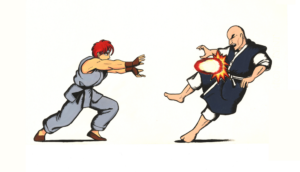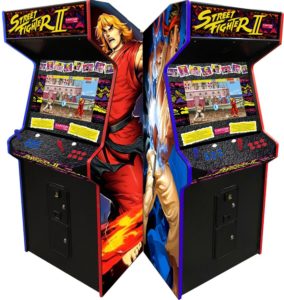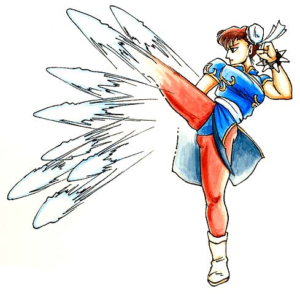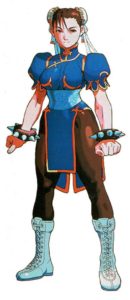“Prior to Street Fighter, there were shooters and driving games where enemies or objects would appear, and the player would shoot them down or avoid running into them. And I wanted to add depth with a story. It just happened to be a fighting game, but I wanted there to be a story so it would feel like a movie. We even conceptualized details for the characters that we didn’t put in the game itself — what the characters might like to eat, do they have sisters, other family members, etc. Street Fighter was different from prior games in the amount of depth we gave the characters.”
—Takashi Nishiyama, creator of Street Fighter
Capcom unleashed Street Fighter on August 12, 1987. Mainly developed by Takashi Nishiyama and Hiroshi Matsumoto, the first Street Fighter was inspired by Bruce Lee’s Game of Death, the video game Kung-Fu Master aka Spartan X, and various other sources. The first Street Fighter was so successful four sequels as well as several spinoffs and crossover games would be made. With the franchise’s 35th anniversary coming up in 2022, this is a perfect time to reflect on how Street Fighter revolutionized the gaming industry.
The Video Game Landscape of the 1980s
The 1980s began with video game arcades being illuminated by brightly colored screens and filled with the sounds of coins being dropped into slots, synthetic noises, and players striving for higher scores. Incredibly high sales and net profits made it seem like a party that would never end. Sadly, this success would not last.

The video game market quickly became oversaturated with low quality games – such as E.T. the Extra-Terrestrial — and with computers becoming more popular, sales began to drop. As a piece for Entrepreneur.com points out, video game sales decreased by almost 97% when industry’s revenue went from $3.2 billion in 1983 to $100 million in 1985. Though 1985’s Super Mario Bros. would help revitalize the industry, it would be years before the industry recovered.
In the midst of this uncertainty, Capcom would release Street Fighter, leveling Capcom up from video game business to pop culture goliath.
Street Fighter’s success inspired Capcom to create a sequel. While this first sequel was retooled into 1989’s Final Fight, 1991’s Street Fighter II so successfully built upon its predecessor, that from the arcades to the home console versions, Street Fighter II revolutionized the industry.
Even outside of gaming, there are few sequels that are as consequential as Street Fighter II. To understand why Street Fighter and Street Fighter II had such impacts, one has to understand what trends they created or were at least early to adopt.
Street Fighter’s First Strikes
The first hits in a real fight may not determine the outcome, but they set the tone for combat. Similarly, elements of Street Fighter that were the first or one of the first in the gaming industry set a foundation for future properties.
For example, while Street Fighter lacked the robust move set that future installments would have, its inclusion of Psycho Fire aka “Hadouken!”, Dragon Punch, and Hurricane Kick was the first time a fighting game had special moves. Specifically, these moves stand out because they were not accessible by pushing a button. Players had to learn specific button and joystick combinations in order to use them.

The importance of these special moves cannot be overstated. Imagine playing games your entire life with the understanding that a button press does one thing and a joystick movement does one thing—only to come across a game that allows you to deploy even more powerful moves after a unique control combination that needed to be learned. Suddenly, video gaming required strategy and skill.
Street Fighter’s special moves inspired a generation of gamers to rethink how they interacted with every other video game. In short, the implementation of special moves encouraged people to invest more time and money in Street Fighter so that they could better master this experience.
Contributing to the game’s strategic complexity, Street Fighter also stood out by having substantially more buttons than other arcades at the time. While modern gamers are used to six button controllers, Street Fighter having so many was an anomaly in the 1980s. As Damien McFerran wrote for RedBull.com in 2017, “while most coin-op cabinets had three buttons at most, Capcom’s 1987 title had six – three punch strengths and three kick strengths.”

“This set-up might have seemed like overkill at the time, but it lent the game unparalleled strategic depth; weaker attacks were faster and therefore carried less risk, while stronger blows dealt more damage but left you open to a counter-attack,” McFerran continued. “Street Fighter II would refine this style still further, and it could be argued that Capcom’s fighter normalized larger button quotas for the entire industry.”
Street Fighter II was also the first one-on-one fighting game offering several characters that players could select. Since these characters had separate strengths, weaknesses, and move sets, this game allowed for a wide variety of matches. Street Fighter II’s multiplayer feature, which allowed players to go head-to-head, proved incredibly influential. Not only did future fighting games mirror this feature, it would even inspire John Romero inclusion of deathmatch mode in Doom.
Chun-Li, One of the Greatest Female Characters of All Time

The huge cast of characters that the Street Fighter franchise has become known not only enables a multitude of match ups, but it has contributed to the presence of women and other minorities in gaming. Afterall, while Chun-Li was not the first female character when she debuted in Street Fighter II, she has impacted popular culture in a way few other women ever have.
“Few will ever underestimate the influence of fighting games on the video game industry, but did you know that Street Fighter has a wholly unique claim to fame? Street Fighter pioneered feminism in the video game industry through the character of Chun-Li,” Patricia Sarkar wrote for Geeks in 2016.
“Video games as a whole were relatively sparse on female characters, and they still are to this day. Much like every other entertainment industry, the main roles are primarily dominated by male, white characters,” Sarkar continued. “Chun-Li was the exception to this rule, and started the move towards a more diverse line of characters. Chinese and a woman, she was perhaps one of the greatest first female characters of all time.”
This sentiment was also echoed in a 2018 piece from Vice by Christobel Hastings.
“In the midst of this digital world designed, developed, and dominated by men, Chun-Li defied expectations about women in games entirely. She wore an athletic modified qipao, combat boots, spiked cuffs around each wrist, and had massive, impressively toned muscles,” Hastings wrote. “Plus, she was one of the best competitive Street Fighter characters; her speed, agility, and match-ending Super Combos proved a devastating mix for her opponents, and ensured top-tier dominance throughout the series.”

Discussions of diversity and inclusion are commonplace, and have led to rightful increase in the representations of minorities and women in media. So, given how little concern there was to representation in the media in the early 1990s, it is impossible to understate the impact Chun-Li had by carving out a space in gaming for female characters to be more than damsels or eye candy.
Street Fighter’s Legacy
While imitation might be the sincerest form of flattery to some, imitation in the gaming industry is the sincerest sign of success. And with Street Fighter a commercial and critical success, dozens of games were developed to chase profits in the fighting game genre. Some of Street Fighter’s competitors are still remembered and enjoyed today; a few of these being Mortal Kombat, Tekken, Killer Instinct, and Darkstalkers.
Street Fighter’s importance is more than its impact on gaming. As a pop culture phenomenon, the franchise has influenced non-video game media.
As with many successful video game titles, Street Fighter has been adapted into movies, cartoons, comic books, and other media. However, a greater sign of Street Fighter’s is its presence outside of traditional transmedia development. For instance, even before esports became mainstream, Street Fighter II’s popularity not only brought people back to arcades, it inspired the creation of fighting game communities; communities which frequently hosted Street Fighter tournaments. Even with the development and popularization of other fighting games, Street Fighter remains a cornerstone of esports competitions.
Outside of esports, Street Fighter has been referenced in various television shows and movies. For instance, the Adventure Time episode “Bad Portrait” contains multiple mentions of Street Fighter. And even more surprising than Jackie Chan becoming Chun-Li in the movie City Hunter, are Street Fighter villains Zangief and M. Bison appearing in Disney’s Wreck-It Ralph.

Vice’s episode of Reset, “Inside the World of Fighting Games,” highlights how Street Fighter centered fighting communities sprung mainly in cities like New York and Los Angeles. Given that these cities were home to hip hop and rap artists developing their voices, it should come as no surprise that hip hop and rap music was influenced by Street Fighter. Some of the many performers to reference Street Fighter in their music are Nicki Minaj, Lupe Fiasco, Dizzee Rascal, Lil B, Sean Price, Madlib, and more.

A key reason for this is that the franchise was so big that artists knew that references to it would be easily understood.
“Street Fighter is just a huge cultural thing that everyone experienced growing up, the characters are hugely recognizable as well as the moves,” Logan Sama, a DJ and Street Fighter fan explained to Paste Magazine. “Street Fighter II basically fathered the modern 2D fighting game genre all by itself. It had such a huge impact that it has just stayed in everyone’s consciousness.”
And with a new generation of professional creatives being born every moment and Street Fighter still incredibly popular, it is only correct to assume that only more songs and other forms of media referencing this franchise will be created.
Future
No date for Street Fighter VI’s release has been announced, but it is known that this game is being developed. As one of the longest going and best selling gaming franchises, it will continue to evolve the video game industry and impact pop culture.

